绿色化学----浊点萃取和悬浮液滴分散液液微萃取技术在中药及制剂检测中的应用
分散液-液微萃取技术在污染物分析中的应用
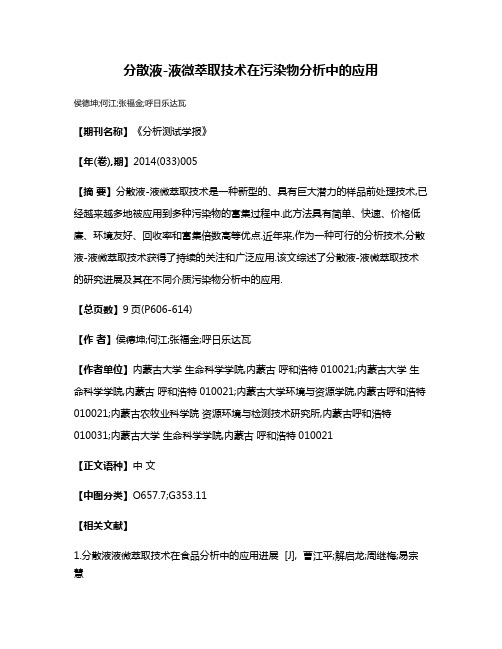
分散液-液微萃取技术在污染物分析中的应用
侯德坤;何江;张福金;呼日乐达瓦
【期刊名称】《分析测试学报》
【年(卷),期】2014(033)005
【摘要】分散液-液微萃取技术是一种新型的、具有巨大潜力的样品前处理技术,已经越来越多地被应用到多种污染物的富集过程中.此方法具有简单、快速、价格低廉、环境友好、回收率和富集倍数高等优点.近年来,作为一种可行的分析技术,分散液-液微萃取技术获得了持续的关注和广泛应用.该文综述了分散液-液微萃取技术的研究进展及其在不同介质污染物分析中的应用.
【总页数】9页(P606-614)
【作者】侯德坤;何江;张福金;呼日乐达瓦
【作者单位】内蒙古大学生命科学学院,内蒙古呼和浩特010021;内蒙古大学生命科学学院,内蒙古呼和浩特010021;内蒙古大学环境与资源学院,内蒙古呼和浩特010021;内蒙古农牧业科学院资源环境与检测技术研究所,内蒙古呼和浩特010031;内蒙古大学生命科学学院,内蒙古呼和浩特010021
【正文语种】中文
【中图分类】O657.7;G353.11
【相关文献】
1.分散液液微萃取技术在食品分析中的应用进展 [J], 曹江平;解启龙;周继梅;易宗慧
2.分散液液微萃取技术在临床样品中的前沿应用 [J], 李冬;谢新民;黄木土;李辉;刘珊
3.分散液液微萃取技术在纺织品禁用偶氮染料检测中的应用 [J], 范娟
4.分散液液微萃取技术在临床样品中的前沿应用 [J], 李冬;谢新民;黄木土;李辉;刘珊;
5.分散液液微萃取技术在毒品分析中的应用 [J], 杨晶; 康明星; 宋爱英
因版权原因,仅展示原文概要,查看原文内容请购买。
简述分散液-液微萃取技术及其应用
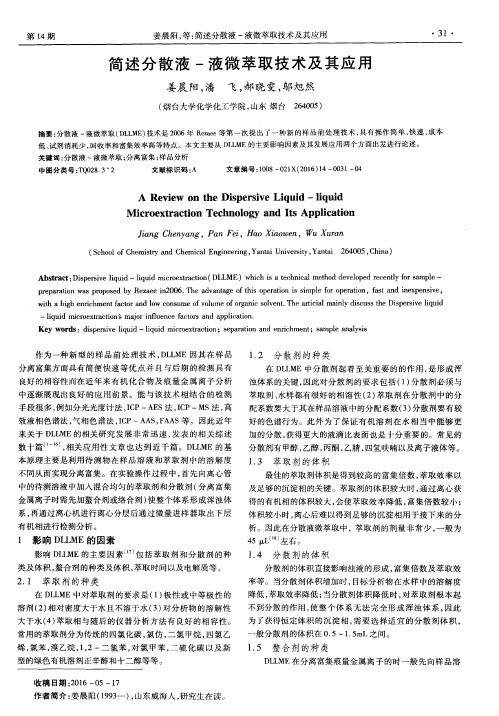
中逐渐 展现出 良好 的应 用前 景。能与该 技 术相结 合 的检测 萃取剂 、水样都有很 好 的相 溶性 (2)萃取 剂在 分散剂 中的分
手 段很 多 ,例如分 光光度计法 ,ICP—AES法 ,ICP—MS法 ,高 配系数要大 于其在样 品溶 液中的分配系数 (3)分散剂要有 较
效液相 色谱 法 ,气相色 谱法 ,ICP—AAS,FAAS等 。因此近 年 好的色谱行为 。此外 为 了保 证有 机溶 剂在水 相 当 中能够更
大 于水 (4)萃取相与 随后 的仪 器分 析方法 有 良好 的相容 性 。 为了获得恒定体积 的沉淀 相 ,需要 选择 适宜 的分 散剂体 积 ,
常用 的萃取剂分 为传统的 四氯化碳 ,氯仿 ,二氯 甲烷 ,四氯 乙 一 般分散剂 的体 积在 0.5—1.5mL之 间。
1 影响 DLLME的 因素
45 左 右 。
影 响 DLLME的主要 因素 包 括萃 取剂 和分 散剂 的种 1.4 分 散 剂 的体 积
类及体 积 ,螯合剂 的种类及 体积 ,萃取 时间以及电解质等 。
分散剂 的体积直接影 响浊液 的形成 ,富集倍数 及萃取效
2.1 萃取 剂 的种 类
率等。当分散剂体积增加时 ,目标分析物 在水样 中的溶解度
在 DLLME中对萃取 剂的要求 是 (1)极性或 中等极性 的 降低 ,萃取效率 降低 ;当分散剂体积 降低时 ,对萃取 剂根本起
溶剂 (2)相对 密度大于水且不溶 于水 (3)对分 析物 的溶解性 不到分 散的作用 ,使 整个 体 系无法 完全形 成 浑浊体 系 ,因此
作为一种新 型 的样 品前 处理 技术 ,DLLME因其 在样 品 1.2 分散 剂 的种 类
液相微萃取或后萃取技术在中药苯丙酸类化合物分析中的使用
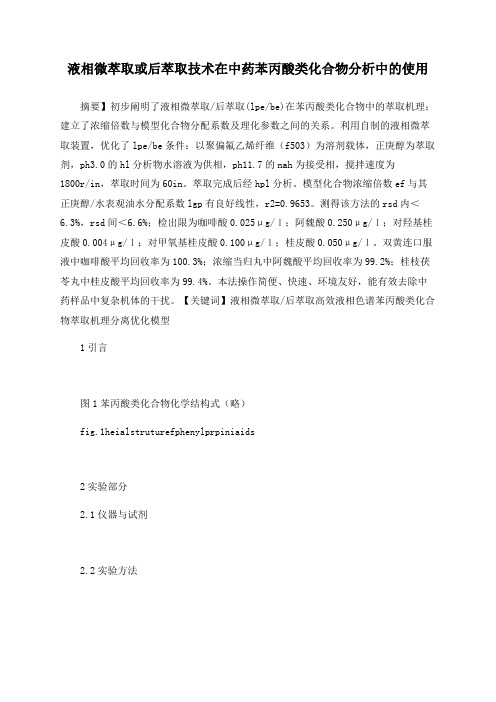
液相微萃取或后萃取技术在中药苯丙酸类化合物分析中的使用摘要】初步阐明了液相微萃取/后萃取(lpe/be)在苯丙酸类化合物中的萃取机理;建立了浓缩倍数与模型化合物分配系数及理化参数之间的关系。
利用自制的液相微萃取装置,优化了lpe/be条件:以聚偏氟乙烯纤维(f503)为溶剂载体,正庚醇为萃取剂,ph3.0的hl分析物水溶液为供相,ph11.7的nah为接受相,搅拌速度为1800r/in,萃取时间为60in。
萃取完成后经hpl分析。
模型化合物浓缩倍数ef与其正庚醇/水表观油水分配系数lgp有良好线性,r2=0.9653。
测得该方法的rsd内<6.3%,rsd间<6.6%;检出限为咖啡酸0.025μg/l;阿魏酸0.250μg/l;对羟基桂皮酸0.004μg/l;对甲氧基桂皮酸0.100μg/l;桂皮酸0.050μg/l。
双黄连口服液中咖啡酸平均回收率为100.3%;浓缩当归丸中阿魏酸平均回收率为99.2%;桂枝茯苓丸中桂皮酸平均回收率为99.4%。
本法操作简便、快速、环境友好,能有效去除中药样品中复杂机体的干扰。
【关键词】液相微萃取/后萃取高效液相色谱苯丙酸类化合物萃取机理分离优化模型1引言图1苯丙酸类化合物化学结构式(略)fig.1heialstruturefphenylprpiniaids2实验部分2.1仪器与试剂2.2实验方法2.2.2溶液配制精密称取5种化合物各10.0g,用甲醇溶解并稀释,制成浓度为1.0g/l的对照品储备溶液,4℃冰箱保存,备用。
2.2.3实验步骤将放有微型搅拌磁子的细长小玻璃管固定于磁力搅拌器上,加入2l样品溶液。
将10长的中空纤维管洗净吹干后在正庚醇中浸泡10s,使其孔壁充满正庚醇,然后用注射器推出纤维管内多余的正庚醇,将此中空纤维管弯曲成u形并注入ph11.7的nah溶液,浸入到样品溶液中,开启磁力搅拌器,在1800r/in搅拌速度下萃取60in,萃取结束后收集接受相,进行hpl分析。
萃取技术在医药制剂中的应用
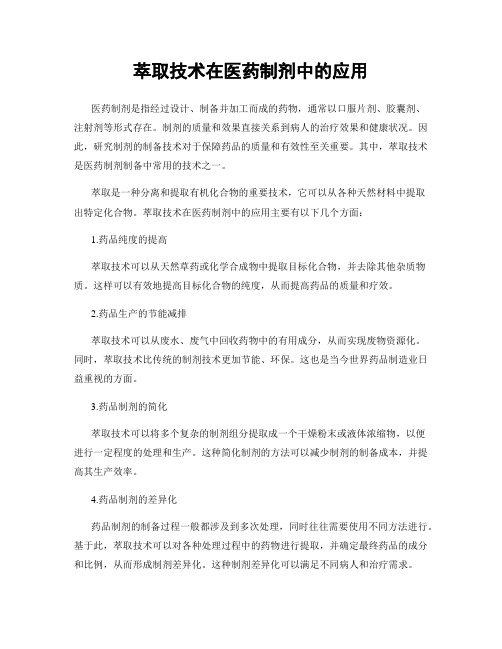
萃取技术在医药制剂中的应用医药制剂是指经过设计、制备并加工而成的药物,通常以口服片剂、胶囊剂、注射剂等形式存在。
制剂的质量和效果直接关系到病人的治疗效果和健康状况。
因此,研究制剂的制备技术对于保障药品的质量和有效性至关重要。
其中,萃取技术是医药制剂制备中常用的技术之一。
萃取是一种分离和提取有机化合物的重要技术,它可以从各种天然材料中提取出特定化合物。
萃取技术在医药制剂中的应用主要有以下几个方面:1.药品纯度的提高萃取技术可以从天然草药或化学合成物中提取目标化合物,并去除其他杂质物质。
这样可以有效地提高目标化合物的纯度,从而提高药品的质量和疗效。
2.药品生产的节能减排萃取技术可以从废水、废气中回收药物中的有用成分,从而实现废物资源化。
同时,萃取技术比传统的制剂技术更加节能、环保。
这也是当今世界药品制造业日益重视的方面。
3.药品制剂的简化萃取技术可以将多个复杂的制剂组分提取成一个干燥粉末或液体浓缩物,以便进行一定程度的处理和生产。
这种简化制剂的方法可以减少制剂的制备成本,并提高其生产效率。
4.药品制剂的差异化药品制剂的制备过程一般都涉及到多次处理,同时往往需要使用不同方法进行。
基于此,萃取技术可以对各种处理过程中的药物进行提取,并确定最终药品的成分和比例,从而形成制剂差异化。
这种制剂差异化可以满足不同病人和治疗需求。
5.药品的特殊性药品本身在分解和处理过程中会有许多特殊的涂层和配方,这些涂层和配方一般并无医学上的意义,但是却对药品的成分和性质产生一定的影响。
萃取技术可以将特殊配方的药品从原料中提取出来,从而获得特殊的药品性质和理化特性。
综上所述,萃取技术在医药制剂中的应用是非常广泛的。
通过萃取技术可以提高药品的纯度和质量,同时还可以使得药品的生产更加环保和节能。
萃取技术也可以控制药品的成分和比例,以满足病人的不同需求。
相信萃取技术在未来药品制剂的制备中将发挥越来越重要的作用。
分散液液微萃取快速测定中药中4种呋喃香豆素化合物
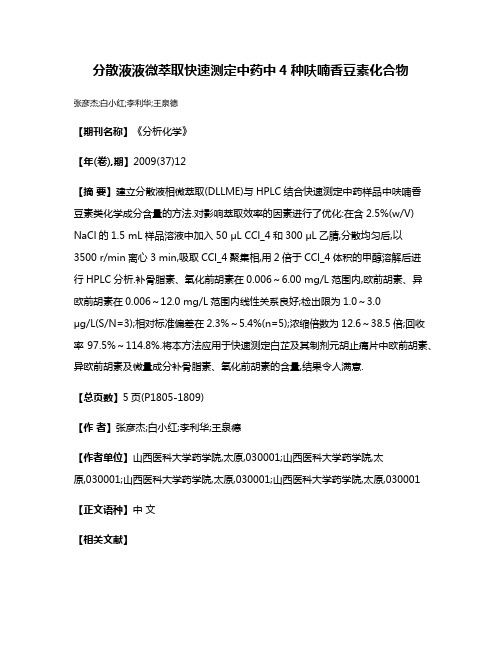
分散液液微萃取快速测定中药中4种呋喃香豆素化合物张彦杰;白小红;李利华;王泉德【期刊名称】《分析化学》【年(卷),期】2009(37)12【摘要】建立分散液相微萃取(DLLME)与HPLC结合快速测定中药样品中呋喃香豆素类化学成分含量的方法.对影响萃取效率的因素进行了优化:在含2.5%(w/V) NaCl的1.5 mL样品溶液中加入50 μL CCl_4和300 μL乙腈,分散均匀后,以3500 r/min离心3 min,吸取CCl_4聚集相,用2倍于CCl_4体积的甲醇溶解后进行HPLC分析.补骨脂素、氧化前胡素在0.006~6.00 mg/L范围内,欧前胡素、异欧前胡素在0.006~12.0 mg/L范围内线性关系良好;检出限为1.0~3.0μg/L(S/N=3);相对标准偏差在2.3%~5.4%(n=5);浓缩倍数为12.6~38.5倍;回收率97.5%~114.8%.将本方法应用于快速测定白芷及其制剂元胡止痛片中欧前胡素、异欧前胡素及微量成分补骨脂素、氧化前胡素的含量,结果令人满意.【总页数】5页(P1805-1809)【作者】张彦杰;白小红;李利华;王泉德【作者单位】山西医科大学药学院,太原,030001;山西医科大学药学院,太原,030001;山西医科大学药学院,太原,030001;山西医科大学药学院,太原,030001【正文语种】中文【相关文献】1.沙田柚果肉汁中呋喃香豆素类化合物的液相色谱-质谱联用研究 [J], 丘秀珍;陶敬奇;王辉;王三永;李春荣;谢凤妮;熊志勇2.RP-HPLC法测定化妆品中呋喃香豆素含量 [J], 张静3.高效液相色谱-质谱法测定沙田柚果肉汁中的呋喃香豆素类化合物 [J], 王辉;丘秀珍;陶敬奇;王三永;李春荣;谢凤妮;熊志勇4.高效液相色谱法同时测定不同来源柑橘幼果中10种类黄酮化合物和香豆素类化合物 [J], 岳超;赵维良;郭增喜;刘柱;张文婷5.薄层扫描法测定中药白芷中香豆素类化合物的含量 [J], 韩娟;张会利因版权原因,仅展示原文概要,查看原文内容请购买。
液相微萃取技术在样品药物检测中的运用

液相微萃取技术在样品药物检测中的运用
液相微萃取是一种常用的前处理技术,可用于样品药物检测中。
其原理是利用离子液体、有机溶剂或表面活性剂等微量的捕获剂,将目标化合物从样品中萃取出来使其富集到少量的萃取相中,从而达到加速样品前处理的目的。
液相微萃取技术具有操作简单、节约时间、节省药物使用量等优点,受到广泛关注和应用。
液相微萃取的主要特点是在无水体系中进行,以减少样品的消耗,同时增加了样品前处理的选择性和灵敏度。
该技术具有分析速度快、选择性高、检测极限低等优点,有望成为常规样品前处理技术。
液相微萃取技术主要适用于有机物和水溶性有机物的前处理,在生物样品中的应用也日渐增多。
例如,在药物检测中,液相微萃取技术一般应用于人体生物样品(如尿液、血液、唾液等)的前处理。
利用液相微萃取技术进行药物检测时,需要确定合适的捕获剂、最佳化提取条件以及合适的检测方法等因素,以确保准确性和可重复性。
液相微萃取技术在药物检测中的应用已经得到了证实,例如在血液样品的前处理中,等离子体氧化物谱分析液相微萃取技术被证明可以在低浓度下检测出小分子靶向药物;在尿液样品的前处理中,液相微萃取技术相对于固相萃取是更具竞争性的前处理方式,具有更好的选择性和高灵敏度,可以用于检测多种药物。
总之,液相微萃取技术在药物检测中的应用是十分重要的,尤其是在生物样品的前处理中具有广泛的应用前景。
未来,这一技术将继续被广泛采用,并将不断发展出更加高效和精准的前处理方法,为药物检测质量和效率的提升做出更大的贡献。
简述液相微萃取技术在样品药物检测中的运用

简述液相微萃取技术在样品药物检测中的运用
液相微萃取技术是一种能够快速提取和富集样品中目标物质的方法,通常用于样品中药物检测。
它的最大优点是可大幅度减少样品量和操作时间,提高药物检测准确性和灵敏度。
液相微萃取技术把样品通过微孔板、小管或其它微结构载体,利用小分子有机溶剂(如甲醇、醚类、酯等)与水形成的两相不相容性来提取并浓缩药物。
在此流程中,微萃取装置可接收能量以使样品中的物质转移到有机溶剂中,特殊技术可帮助药物在水和有机相中的平衡移动,使药物更容易被提取。
液相微萃取技术的优势在于在少量的有机溶剂中就能够快速且高效地提取药物,同时很多有机溶剂易挥发,只需几分钟即可完成提取。
这也有助于避免样品污染,并减少分析所需的时间和成本。
此外,由于这种方法只需用到极少的样品,可以将样品原料的损失降至最小。
目前,液相微萃取技术在各种药物的检验中都有应用。
例如,它可以在大量的样本中对阿托伐他汀进行测量;对硫氯妥钠,吗啡等药物进行定量测定等。
在药物检测中,尤其是在血浆检测中,使用液相微萃取技术可控制物质暴露程度,从而使药物的峰值高度较为准确。
液相微萃取技术可以缩短提取时间、提高提取效果和减少副反应,也可以使样品减少消耗,具有省时省力效益和环保等诸多优点,因此广受药物分析和检测研究人员的推崇。
分散液相微萃取技术在药物分析中的应用

c u ia s e tc l
ZHANG ig MA n xa 。 ANG n (1 Gu n d n h r c u ia ie st Gu n z o 1 0 6。 ia 2 Th is Jn , Ho g i W Ya . a g o g P ama e t lUnv ri c y。 a g h u 5 0 0 Chn ; . e F rt Afiae s i lo a g h u Me iieC l g - a g h u 5 0 2 Chn ) f itd Ho pt fGu n z o dcn o l e Gu n z o 1 1 0, ia l a e
i om ii ppr c n f s s a pr sng a oa h i a tpha m a e ia n l ss r c utc la a y i.
Ke r s DLLM E; h r c u ia n l ss s mp e p e a a i n y wo d : p a ma e t l a y i ; a l r p r t c a o
n l ss o h r c u ia s M e h d A a g u b ro o e tca d f r i n l e a u e r e re e . u t e mo e t er lt d l — a y i fp a ma e t l. c t o lr e n m e fd m si n o eg i r t r s we er ti v d F rh r r 。 h ea e i t t e a u e r n l z d a d s mma i d Re u tDLLM E i a n w a l p e a a in a p o c wh c a tr ce c n e e t r t r s we e a a y e n u rz . s l e s e s mp e r p r t p r a h, ih h s a t a t d mu h i t r s o
- 1、下载文档前请自行甄别文档内容的完整性,平台不提供额外的编辑、内容补充、找答案等附加服务。
- 2、"仅部分预览"的文档,不可在线预览部分如存在完整性等问题,可反馈申请退款(可完整预览的文档不适用该条件!)。
- 3、如文档侵犯您的权益,请联系客服反馈,我们会尽快为您处理(人工客服工作时间:9:00-18:30)。
密级:学校代码:10075分类号:学号:20090955理学硕士学位论文浊点萃取和悬浮液滴分散液液微萃取技术在中药及制剂检测中的应用学位申请人: 颜骏景指导教师: 石志红 教授学位类别: 理学硕士学科专业: 分析化学授予单位: 河北大学答辩日期: 二〇一二年六月Classified Index: CODE:10075 U.D.C: NO:20090955A Dissertation for the Degree of M. S.The Application of the Cloud-point Extraction Method and DLLME-SFO Technique in the Determination ofTraditional Chinese Herb andPreparationCandidate: Yan JunjingSupervisor: Prof. Shi ZhihongAcademic Degree Applied for: Master of ScienceSpecialty: Analytical ChemistryUniversity: Hebei UniversityDate of Oral Examination: June,2012摘 要中药材历史悠久,资源丰富,具有很高的实用价值和丰富的科学内容,是我国医药宝典中的重要组成部分。
但近些年因中药材中有害成分的残留影响了中药材的品质,同时阻碍了中药材走进国际市场的脚步,成为中药材发展的瓶颈。
为了尽早达到国际贸易的检测和限量标准,建立一套简便、快速、有效的检测技术具有十分重要的意义。
中药制剂的质量控制标准是决定中药制剂能否在国内外顺利发展的重中之重,解决质量控制技术问题迫在眉睫。
对中药制剂中多个有效成分的定性、定量检测是使中药制剂的质量控制得到提高的有效方法之一。
本文中详细介绍了一种新型的萃取方法,对中药制剂的质量控制标准制定和关键技术问题均能起到指导的作用。
全文共分为三章:第一章:在参考大量文献的基础上,对中药材中有害物质的前处理方法进行归纳总结,同时对中药制剂质量控制方法进行综述。
第二章:建立了超声辅助-浊点萃取法萃取中药材中多环芳烃并采用高效液相色谱-荧光检测器进行检测。
对表面活性剂浓度、超声波辅助提取时间、液固比、盐浓度以及平衡时间和温度等诸因素进行了优化。
五种多环芳烃在0.05-20 ng/mL的浓度范围内,峰面积对浓度的线性关系良好,相关系数在0.9989-0.9999之间,此方法已成功应用于地黄、板蓝根、黄莲、白芪、黄芩等五种中药材中多环芳烃残留的检测。
相对标准偏差为4.6 %-6.6 %。
在最佳条件下对地黄、板蓝根、黄莲、白芪、黄芩五种中药材中多环芳烃的含量进行测定。
第三章:建立了一种新型的悬浮凝固液滴-分散液液微萃取测定复方丹参注射液中丹参酮的新方法。
对分散剂和萃取剂的种类和用量以及离心速率和盐效应进行了优化。
在最佳条件下对四种品牌的复方丹参注射液中的丹参酮进行了检测。
本方法具有检出限低、耗用有机溶剂少、萃取时间短、灵敏度高、重现性好、操作简便等优点。
关键词 HPLC 浊点萃取法 悬浮凝固液滴-分散液液微萃取法 多环芳烃 丹参酮AbstractChinese herbal medicine is an ancient but still dynamic academic subject with high practical value. Chinese herbal medicines have been an important part of Chinese Pharmacopoeia. Recently, the residues of harmful ingredients in the herbal medicines affect the quality of the medicines, and hinder the pace of Chinese herbal medicines into the international market. So it has become the bottle-neck of the development of Chinese herbal medicines. In order to achieve the detection limits for international trade as soon as possible, establishing a simple, rapid and effective detection technology has a great significance.The undefined quality control standard has limited the development of Chinese herbal medicine internationally for a long time. Therefore, it has been a big issue to define the standard. One of the solutions is qualitative and quantitative determination of multiple effective test components in Chinese herbal medicine. This paper describes a new extraction method which plays a guiding role both in the definition of Chinese herbal medicine quality control standard and the solving of key technical problems in it.The paper has 3 chapters:Chapter 1: The pre-treatment methods of harmful substances in herbal medicines are summarized on the basis of large number of papers. At the same time, the quality control of traditional Chinese medicine preparation is reviewed.Chapter 2: A technique named Cloud Point Extraction adopted to extract and determine polycyclic aromatic hydrocarbons (PAHs) residues in Chinese Medicinal Materials is validated. HPLC coupled with a fluorescence detector is used for qualitative analysis.The effect of some parameters, for example, ultrasonic time and the cloud extraction, are optimized. On the optimized conditions, the PAHs of rehmannia, radix isatidis, goldthread root, Baiqi and scutellaria are measured. The experimental results show that it is a simple and fast pre-treatment method.Chapter 3: Dispersive Liquid-Liquid micro-extraction based on the solidification of a floating organic droplet (DLLME-SFO) followed by high-performance liquid chromatography-UV (HPLC-UV) is applied for enrichment and detection of Cryptotanshinone, Tanshinone I and Tanshinone IIA in Traditional Chinese Medicinal Injections Containing Salvia Miltiorrhiza Bunge. The important variable parameters, forexample, the type of disperser and extraction solvent and the volume of disperser and extraction solvent, are optimized. On the optimized conditions, different brands of tanshinone injectors are determined. This method with less organic solvent consumption is not only more accurate, but also fast and easy.Keywords HPLC Cloud-point extraction DLLME-SFO PAHs Tanshinone目 录第1章综述 (1)1.1 中药材有害残留物前处理技术 (1)1.2 中药材制剂前处理方法概述 (6)1.3 选题思想 (9)第2章浊点萃取-高效液相色谱法测定中药材中多环芳烃的残留 (11)2.1 引言 (11)2.2 实验部分 (12)2.2.1 仪器装置 (12)2.2.2 化学品和试剂 (12)2.2.3 萃取过程 (12)2.2.4 色谱条件 (13)2.3 结果和讨论 (13)2.3.1 浊点萃取条件的优化 (13)2.3.2 方法的线性范围和检出限 (17)2.3.3 样品测定 (18)2.4 结论 (18)第3章悬浮凝固液滴-分散液液微萃取测定复方丹参注射液中丹参酮 (20)3.1 引言 (20)3.2 实验部分 (21)3.2.1 仪器与试剂 (21)3.2.2 色谱条件 (22)3.2.3 实验方法 (22)3.3 结果与讨论 (23)3.3.1 DLLME-SFO萃取条件的优化 (23)3.3.2 方法的线性范围、精密度、重现性和检出限 (27)3.3.3 样品分析 (28)3.4 结论 (28)参考文献 (29)致谢 (35)攻读学位期间取得的科研成果 (36)第1章综述近些年,随着对食品安全、环境等问题的重视,中药材及制剂的监控也逐渐引起国家的关注。
